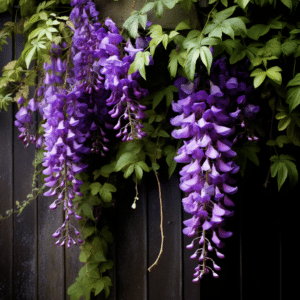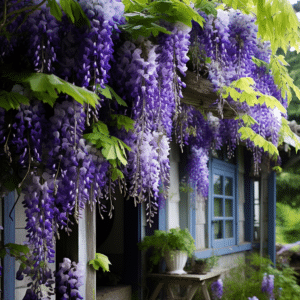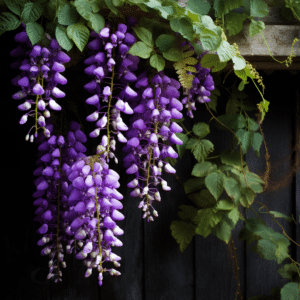Wisteria, with its stunning, fragrant blooms and vigorous growth, is a favorite among garden enthusiasts. This climbing vine, native to the United States, China, Korea, and Japan, can transform any garden into a vibrant, aromatic paradise. However, growing wisteria requires a certain level of knowledge and care. This guide will provide you with all the information you need to successfully grow and maintain your wisteria plant.
Understanding Wisteria

Before we delve into the specifics of growing wisteria, it’s important to understand the plant itself. Wisteria is a genus of flowering plants in the legume family, Fabaceae. It includes ten species of woody climbing vines that are native to the Eastern United States and to China, Korea, and Japan. Wisteria vines climb by twining their stems either clockwise or counterclockwise round any available support.
Wisteria is best known for its stunning, drooping flower clusters, which can range in color from whites, pinks and purples. These flowers not only add a burst of color to your garden, but also produce a sweet, pleasant fragrance that can fill your outdoor space.
Types of Wisteria
There are several types of wisteria, but the most common are the Chinese wisteria (Wisteria sinensis) and the Japanese wisteria (Wisteria floribunda). The Chinese wisteria blooms earlier, usually in May, and its flowers appear before the leaves have fully unfurled. The Japanese wisteria, on the other hand, blooms a little later, and its flowers and leaves tend to appear at the same time.
Both types of wisteria are known for their vigorous growth and can reach heights of up to 20 feet or more. They also both produce long, drooping clusters of flowers, although the clusters on the Japanese wisteria tend to be a bit longer.
Planting Wisteria

Once you’ve chosen the type of wisteria you want to grow, the next step is planting. Wisteria can be grown from seed, but it can take up to 20 years for seed-grown plants to bloom. For this reason, most gardeners prefer to plant wisteria from cuttings or grafted plants, which can bloom within a few years of planting.
Wisteria should be planted in the spring or fall, in a location with full sun and well-drained soil. The plant prefers a neutral to slightly acidic soil pH, but can tolerate a wide range of soil conditions.
Preparing the Soil
Before planting your wisteria, it’s important to prepare the soil. Start by removing any weeds or grass from the planting area. Then, dig a hole that’s about twice as wide and just as deep as the root ball of your wisteria plant.
Next, amend the soil with organic matter, such as compost or well-rotted manure. This will improve the soil’s fertility and drainage, which are crucial for the healthy growth of your wisteria.
Planting the Wisteria
Once the soil is prepared, you can plant your wisteria. Place the plant in the hole, making sure that the top of the root ball is level with the soil surface. Then, backfill the hole with the amended soil, firming it gently around the root ball.
After planting, water the wisteria thoroughly and apply a layer of mulch around the base of the plant. This will help to conserve moisture and suppress weeds.
Caring for Wisteria

While wisteria is a relatively low-maintenance plant, it does require some care to ensure its healthy growth and abundant blooming. This includes regular watering, feeding, pruning, and pest control.
Wisteria should be watered regularly, especially during dry periods. However, it’s important not to overwater, as this can lead to root rot. As a general rule, water when the top inch of soil feels dry to the touch.
Feeding Wisteria
Wisteria benefits from regular feeding. Apply a balanced, slow-release fertilizer in the spring, just before new growth begins. This will provide the plant with the nutrients it needs to produce lush foliage and abundant blooms.
It’s also a good idea to apply a layer of compost or well-rotted manure around the base of the plant each spring. This will help to improve soil fertility and moisture retention.
Pruning Wisteria
Pruning is crucial for controlling the size of your wisteria and encouraging it to bloom. Wisteria should be pruned twice a year: once in the late winter, before new growth begins, and again in the late summer, after the plant has finished blooming.
Winter pruning involves cutting back the previous year’s growth to 2 or 3 buds. This helps to encourage the development of short, flowering spurs. Summer pruning involves shortening the long, whippy shoots that have grown during the current year to about one foot.
Controlling Pests and Diseases
Wisteria is generally quite resistant to pests and diseases. However, it can sometimes be affected by pests such as aphids and scale insects, and diseases such as leaf spot and powdery mildew.
If you notice any signs of pests or diseases, it’s important to take action immediately. This may involve spraying the plant with an appropriate pesticide or fungicide, or removing and disposing of infected parts of the plant.
Enjoying Your Wisteria
With the right care, your wisteria can provide you with many years of beauty and enjoyment. Its stunning blooms and sweet fragrance can transform your garden into a paradise, and its vigorous growth can provide shade and privacy.
Whether you’re a seasoned gardener or a beginner, growing wisteria is a rewarding experience. With a little knowledge and care, you can successfully grow and enjoy this beautiful, fragrant plant in your own garden.